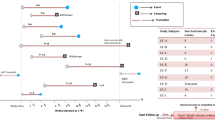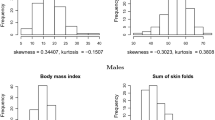Abstract
Various nonparametric test statistics have been proposed for censored data. Two-sample nonparametric testing plays an important role in biometry. While most of two-sample nonparametric tests intend to detect a shift in location or in scale, the two-sample Cucconi test statistic is suitable for the joint comparison of both parameters. The Cucconi test statistic is extended to the left- and right-censored data based on the theory of ties. We derive the limiting distribution of the Cucconi test statistic for censored data. We conduct simulation studies to investigate the convergence of the Cucconi test statistic to the limiting distribution and the power of the proposed statistic with various population distributions. The method is illustrated with an analysis using real data.
Similar content being viewed by others
References
Ansari AR, Bradley RA (1960) Rank-sum tests for dispersions. Ann Math Stat 31:1174–1189
Bagdonavicius V, Kruopis J, Nikulin MS (2011) Non-parametric tests for censored data. Wiley, New York
Büning H (2002) Robustness and power of modified Lepage, Kolmogorov–Smirnov and Cramér–von Mises two-sample tests. J Appl Stat 29:907–924
Büning H, Thadewald T (2000) An adaptive two-sample location-scale test of Lepage type for symmetric distributions. J Stat Comput Simul 65:287–310
Chowdhury S, Mukherjee A, Chakraborti S (2014) A new distribution-free control chart for joint monitoring of location and scale parameters of continuous distributions. Qual Reliab Eng Int 30:191–204
Cucconi O (1968) Un nuovo test non parametrico per il confronto tra due gruppi campionari. G degli Econ 27:225–248
Desu MM, Raghavarao D (2004) Nonparametric statistical methods for complete and censored data. Chapman & Hall/CRC Press, Boca Raton
Epstein B (1954) Truncated life tests in the exponential case. Ann Math Stat 25:555–564
Gehan EA (1965) A generalized Wilcoxon test for comparing arbitrarily singly-censored samples. Biometrika 52:203–224
Halperin M (1960) Extension of the Wilcoxon–Mann–Whitney test to samples censored at the same fixed point. J Am Stat Assoc 55:125–138
Lepage Y (1971) A combination of Wilcoxon’s and Ansari-Bradley’s statistics. Biometrika 58:213–217
Marozzi M (2014) The multisample Cucconi test. Stat Methods Appl 23:209–227
Marozzi M, Reiczigel J (2018) A progressive shift alternative to evaluate nonparametric tests for skewed data. Commun Stat Simul Comput 47:3083–3094
Mukherjee A, Marozzi M (2017a) A distribution-free phase-II CUSUM procedure for monitoring service quality. Total Qual Manag Bus Excell 28:1227–1263
Mukherjee A, Marozzi M (2017b) Distribution-free Lepage type circular-grid charts for joint monitoring of location and scale parameters of a process. Qual Reliab Eng Int 33:241–274
Murakami H (2007) Lepage type statistic based on the modified Baumgartner statistic. Comput Stat Data Anal 51:5061–5067
Neuhäuser M (2000) An exact two-sample test based on the Baumgartner–Weiss–Schindler statistic and a modification of Lepage’s test. Commun Stat Theory Methods 29:67–78
Paul W, Mielke JR (1967) Note on some squared rank tests with existing ties. Technometrics 9:312–314
Pepe MS, Fleming TR (1989) Weighted Kaplan–Meier statistics: a class of distance tests for censored survival data. Biometrics 45:497–507
Peto R, Peto J (1972) Asymptotically efficient rank invariant test procedures. J R Stat Soc Ser A 135:185–198
Pettitt AN (1976) A two-sample Anderson–Darling rank statistic. Biometrika 63:161–168
Rutkowska A, Banasik K (2016) The Cucconi test for location-scale alternatives in application to asymmetric hydrological variables. Commun Stat Simul Comput 45:1–15
Sugiura N (1963) On a generalization of the Wilcoxon test for censored data. Osaka Math J 15:257–268
Sugiura N (1964) A generalization of the Wilcoxon test for censored data II. Several-sample problem. Osaka J Math 1:165–174
Wilcoxon F (1945) Individual comparisons by ranking methods. Biometrics 1:80–83
Author information
Authors and Affiliations
Corresponding author
Additional information
Publisher's Note
Springer Nature remains neutral with regard to jurisdictional claims in published maps and institutional affiliations.
The research of the second author was supported by JSPS KAKENHI Grant Number 18K11199.
Appendices
Proof of Theorem 1
First, we introduce Lemma 1 to show the Theorem 1.
Lemma 1
(Cucconi 1968) Let \(Y_1,Y_2\) be the random variables from the standard normal distribution and \(\rho _*=\mathrm{Corr}(Y_1,Y_2)\). Then,
is distributed as the standard exponential distribution.
If we obtain that \(U_L\) (\(U_R\)) and \(V_L\) (\(V_R\)) have the asymptotic normality for the left- or right-censored data, it is easily to prove the theorem by using Lemma 1. Let \(R_{1j}^*\) be the rank of the uncensored \(X_1\)’s in \(N-r_1-r_2\) uncorrelated observations. In general, the sum of \(R{^{*}_{1j}}^{\beta }\) (\(\beta >0\)) is asymptotically distributed according to normal introduced by Halperin (1960).
1.1 Proof for the left-censored data
\(Q^{L}_{1}\) and \(Q^{L}_{2}\) are decomposed as follows:
where \(N'=N-r\), \(n'_1=n_1-r_1\). Define that
Furthermore, put
The equations \(A_1, \ldots , A_4\), \(B_1, \ldots , B_4\) are rewritten by using the constants a, b, p, q and the random variables t, w, \(\tau \). Then we obtain

Therefore, we re-formulated the \(Q^{L}_{1}\) and \(Q^{L}_{2}\) as follows:
Note that the moment of \(Q^{L}_{1}\) and \(Q^{L}_{2}\) are expressed as following formula:
where \(Q=\sqrt{1-p^5},\)\(Q'=\sqrt{1-\frac{15}{4}p^3q -p^5}\). Hence, the statistics \(U_L\) and \(V_L\) are given by
Note that t, w and \(\tau \) are the asymptotically normal and mutually independent. By taking into account \(\text {E}[U_L]=\text {E}[V_L]=0\), \(\text {var}[U_L]=\text {var}[V_L]=1\), the proof is completed to show for the case of the left-censored data by using Lemma 1.
1.2 Proof for the right-censored data
The equation \(R_{1j}=R^*_{1j}\) holds for the right-censored data. Define that
\(Q^{R}_{1}\) and \(Q^{R}_{2}\) are decomposed as follows:
Since it is rewritten by utilizing the constants a, b, p, q and the random variables t, w, \(\tau \), we obtain

Therefore, we re-formulated \(Q^{R}_{1}\) and \(Q^{R}_{2}\) as follows:
By taking into account for \(\text {var}[Q_{\xi }^{R}]=\text {var}[Q_{3-\xi }^{L}]\), \(\xi =1,2\) and the Eqs. (3), (4), (5), we have
where \(Q=\sqrt{1-p^5}\), \(Q'=\sqrt{1-\small {\tfrac{4}{15}}p^3q-p^5}\). It is noteworthy that \(t_2\) is asymptotically distributed according to N(0, 1) and \(t_2\) and \(\tau \) are mutually independent and \(\text {E}[U_R]=\text {E}[V_R]=0\), \(\text {var}[U_R]=\text {var}[V_R]=1\). Conclusively, the proof is completed to show for the case of the right-censored data by applying Lemma 1.
Proof of Theorem 2
The correlation coefficient between \(U_L\) (\(U_R\)) and \(V_L\) (\(V_R\)) is approximated to

where \(Q=\sqrt{1-p^5}\), \(Q'=\sqrt{1-\small {\tfrac{4}{15}}p^3q-p^5}\). Note that \(p=1-q\). Then the behavior of \(\rho \) on \(p\in (0,1)\) is as follows:
Therefore, f(p) is strictly monotonic decreasing and \(|f(p)| \ne 1\) on (0, 1).
Rights and permissions
About this article
Cite this article
Nishino, T., Murakami, H. The Cucconi statistic for Type-I censored data. Metrika 82, 903–929 (2019). https://doi.org/10.1007/s00184-019-00712-x
Received:
Published:
Issue Date:
DOI: https://doi.org/10.1007/s00184-019-00712-x




